Pop Quiz! Can You Identify the Real Examples of Censorship?
“Divisive concept laws” have had a chilling effect on what’s taught in classrooms across the country. Can you spot the real examples of censorship in schools?
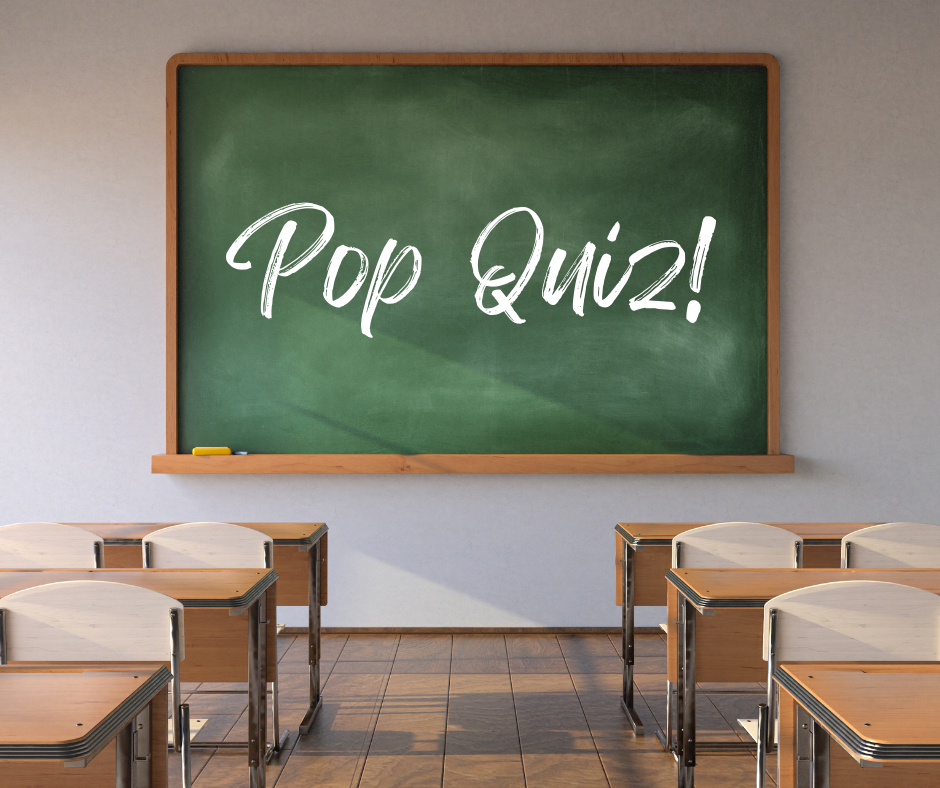
Since 2021, 24 states have adopted educational gag orders limiting speech that is not aligned with narrowly proscribed political views. So-called “divisive concept laws” ban books that are unilaterally deemed “inappropriate” and restrict classroom discussions of race, gender, and sexuality. These measures undermine public education and represent a dangerous abuse of government authority to advance a partisan agenda.
American Oversight obtained and analyzed thousands of pages of records that reveal how the implementation of “divisive concepts” measures creates confusion for educators and undermines the provision of a comprehensive education. To illustrate how the implementation of these policies denies students the opportunity to learn about diverse cultures, basic history, and common identities, we created a quiz based on the documents we obtained that asks you to identify real examples of this censorship. After each question, you will see the correct answer and the original documents the examples are based on, along with more information about states’ efforts to implement these measures.
Let’s begin!
1. Florida: Which math word problem was censored?
Florida Gov. Ron DeSantis has signed multiple bills restricting classroom discussion of racism, gender, and sexuality, beginning in March 2022 with HB 1467. The law includes a mandate that educational media specialists review books for prohibited content.
The year the law was passed, the Florida Education Department rejected 54 of 132 textbooks submitted for review. After the publisher Accelerate failed to receive sufficient clarification on why some of its materials were not recommended, the company conducted its own review of two courses that had been flagged as containing “culturally responsive teaching.”
Which of the following math word problems did Accelerate remove and replace during this review?
A. Invasive Species.
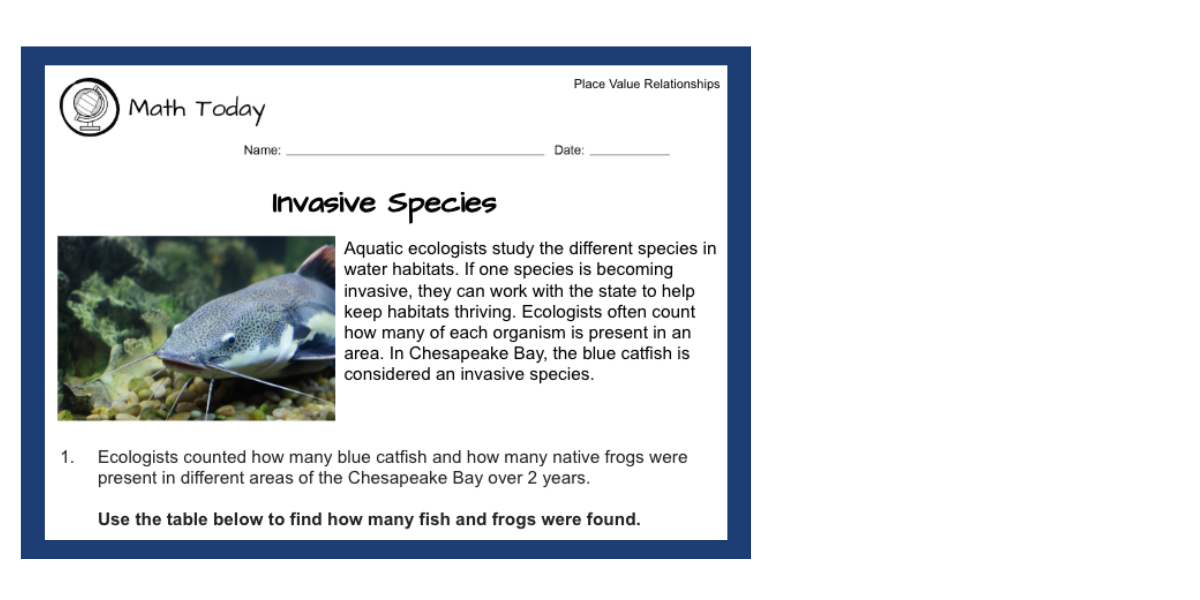
B. A story about competitive video games.
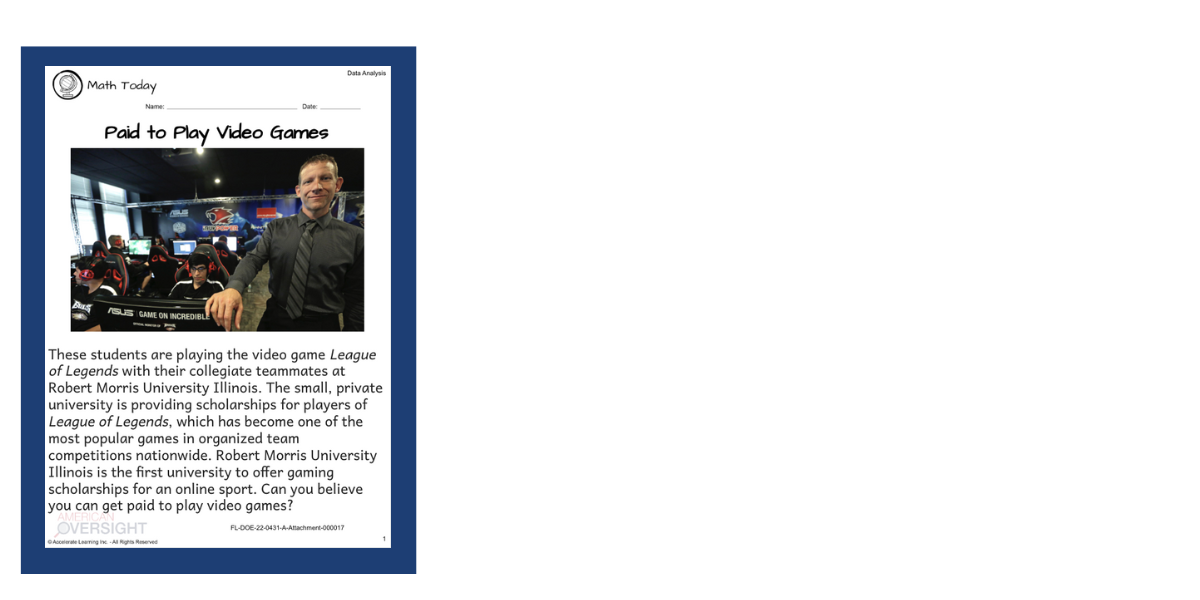
C. Sand Sculptures.
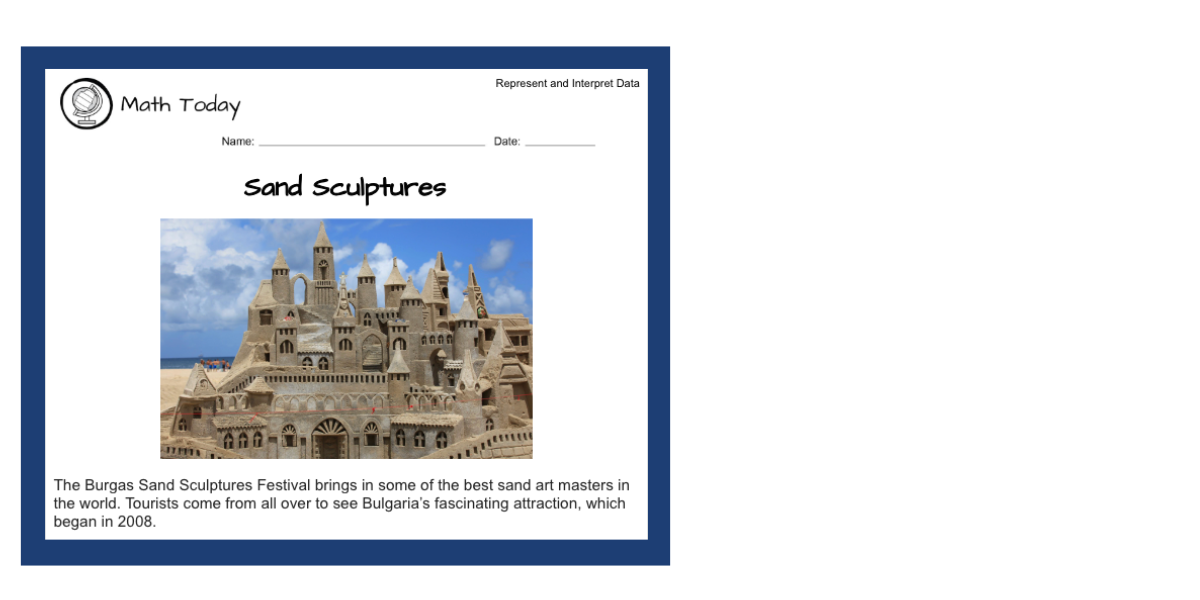
D. A Saturday Well Spent.
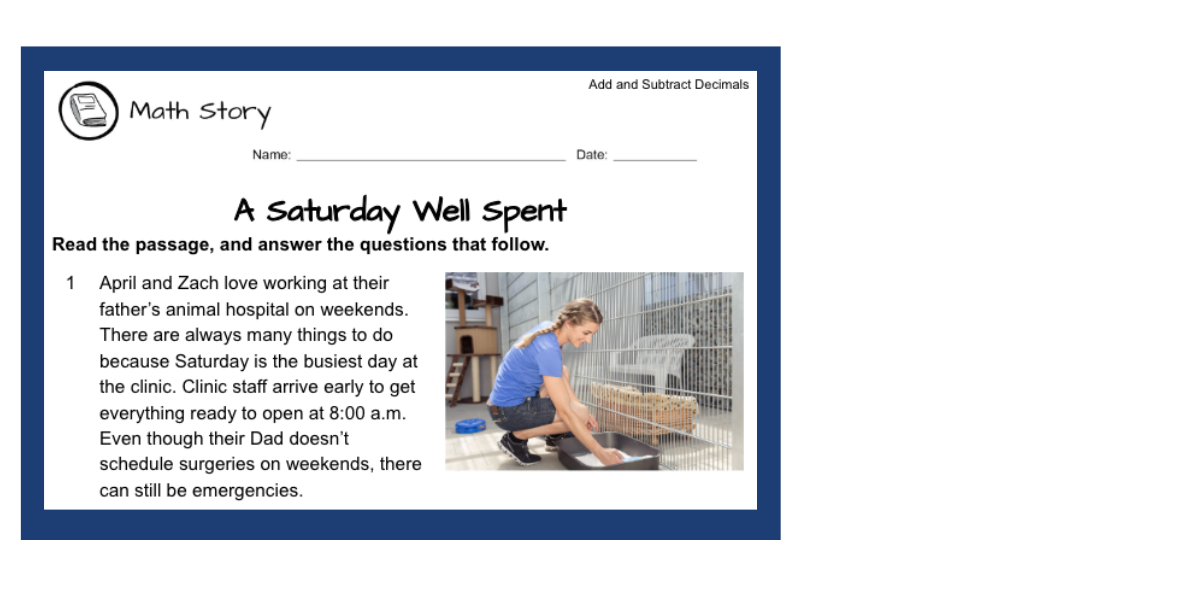

Answer: C
Click here to learn more.
Accelerate removed the word problem about sand sculptures and replaced it with the video games story (this was eventually replaced again with another word problem called “Billiard Balls”).
The “Invasive Species” and “A Saturday Well Spent” stories were replacements for other questions flagged by Accelerate.
2. Which stories were replaced?
Can you identify the two original textbook stories that Accelerate replaced with the “A Saturday Well Spent” and “Invasive Species” examples?
A. A Tale of Two Beverages: A story explaining the global history of coffee and tea, used to introduce adding and subtracting decimal numbers.
B. The Revolution of the Cotton Gin: A story about the spike in cotton production after the invention of the cotton gin, used to teach the concept of doubling and tripling growth.
C. Panning for Gold: A story examining the number of people who joined the American gold rush and the small number who found a significant amount of gold, used to teach fractions.
D. Tropical Storm Pakhar: A passage about a 2017 storm that impacted southern China, Southeast Asia, and the Philippines, used to introduce adding and subtracting decimal numbers.

Answer: A and D
Click here to learn more.
Accelerate removed information about a tropical storm across the ocean from the United States and a story about the history of tea and coffee. Here are the original examples used in the textbook:
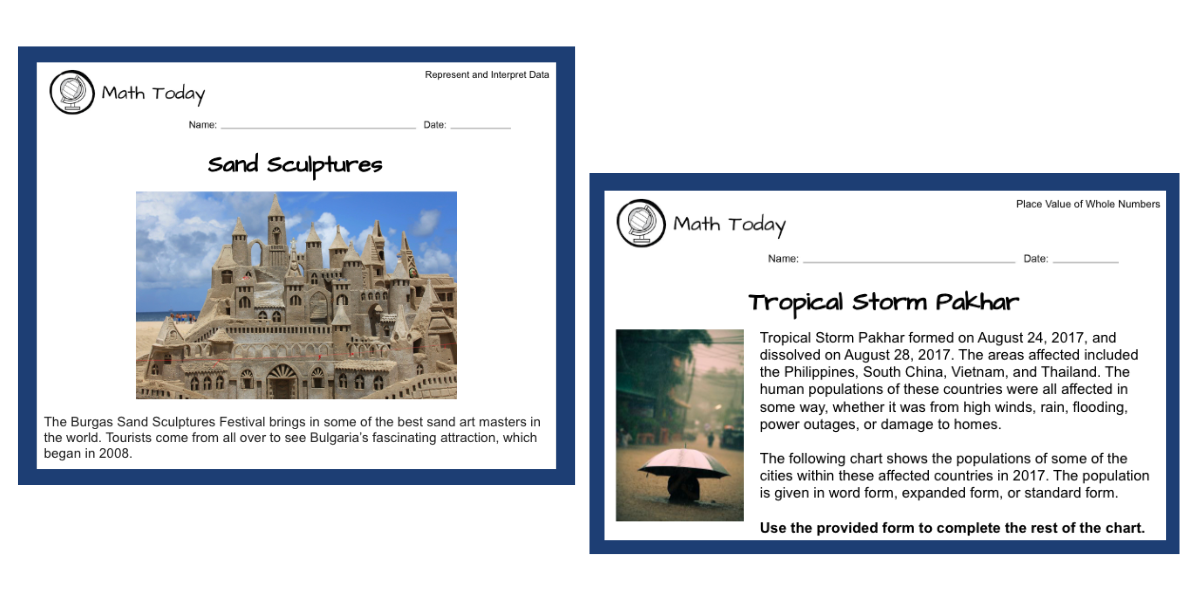
3. Which example was not flagged by Florida?
Accelerate Learning was not the only textbook manufacturer to have its content flagged by the Florida Education Department during its review of instructional materials. Three of the following are real examples of content that the department challenged. Can you identify the imposter?
A. A precalculus textbook that had a question about the spread of a “contagious flu virus.”
B. A precalculus textbook that had a question about “the percentage of individuals living below poverty line in 2016.”
C. A statistics textbook that had a graph representing the decline in teen pregnancy rates since 1980.
D. A statistics textbook that had a graph representing polling data by decade regarding opinions about laws against interracial marriage.
E. A probability and statistics question for grades 9–12 about a white interviewer and a Middle Eastern interviewer receiving different answers to survey questions about drone strikes in Iraq.

Answer: C
Click here to learn more.
All others are real examples of questions flagged by reviewers.
A and B: A spreadsheet tracking appeals from textbook developers mentioned a Cengage precalculus textbook that included a question about the spread of a “contagious flu virus” and another about “the percentage of individuals living below poverty line in 2016.” Reviewers noted that the latter was “not meaningful to students.”
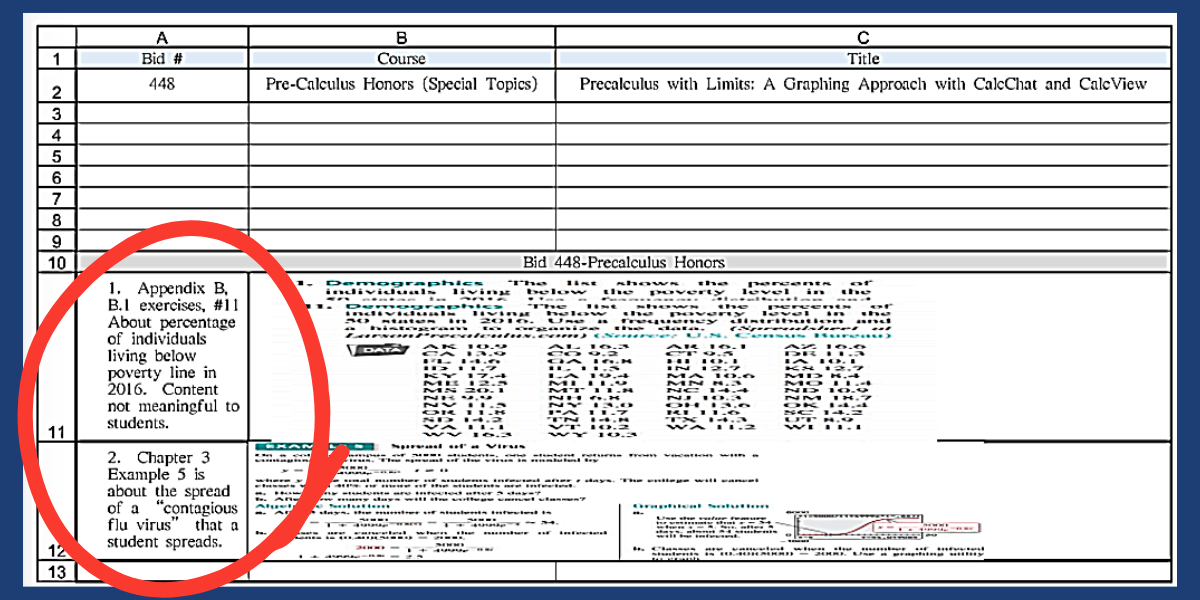
D: Another document, apparently authored by a content reviewer, included a complaint about a graph showing polling data by decade of public opinion on laws against interracial marriage. The graph also mentioned the U.S. Supreme Court’s decision recognizing the right to same-sex marriage. The reviewer wrote that the math problem “goes out of its way” to mention the Obergefell case, “making an analogy that opposing the legalization of same-sex marriage is like the opposition to interracial marriage.”
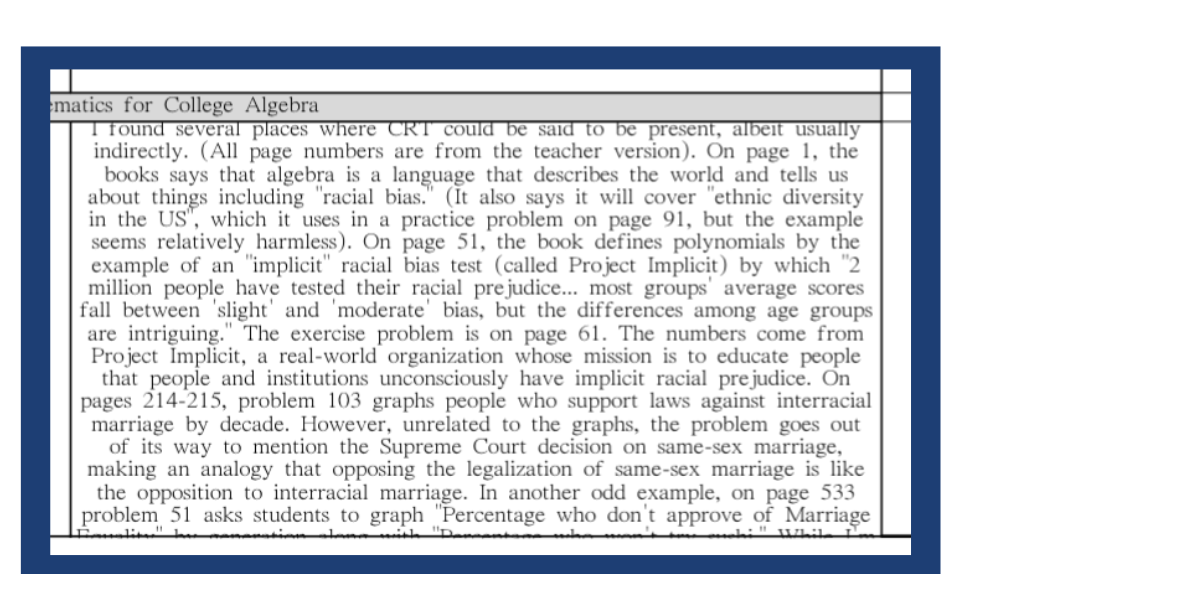
E: After the Education Department flagged this problem, the BFW textbook manufacturer changed a probability and statistics question for grades 9–12. The original question involved a white interviewer and a Middle Eastern interviewer receiving different answers to survey questions about drone strikes in Iraq. The revised word problem instead asked whether the breed of dog walked by the interviewer affected how respondents answered the question, “Do you like dogs?”
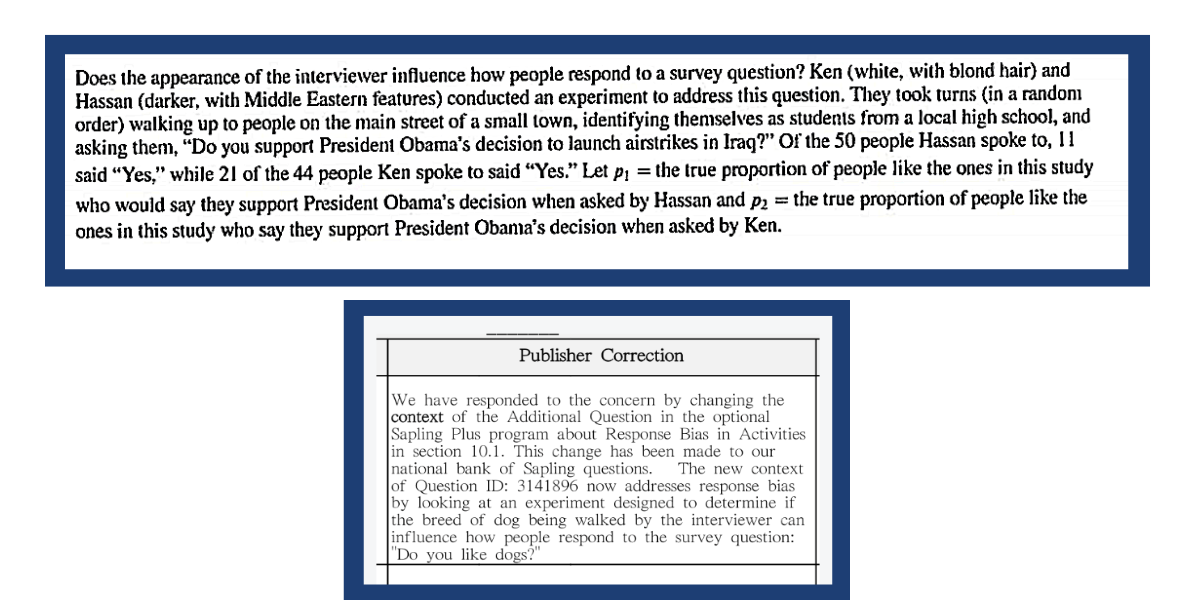
5. Why did Florida reject the AP African American Studies course?
In January 2023, Gov. Ron DeSantis announced that Florida would reject the proposed AP African American Studies course for including “political” content such as “intersectionality and activism” and “Black queer studies.”
Records obtained by American Oversight contain comments from the Florida Department of Education’s internal review of the rejected curriculum.
Which of the following is a real reason reviewers gave for objecting to lessons about slavery and racial disparities in the course?
A. Reviewers claimed the lessons about slavery were lacking in “opposing viewpoints” and called for the inclusion of more than “one side of this issue.”
B. In response to a lesson stating that “Enslaved African Americans had no wages to pass down to descendants, no legal right to accumulate property, and individual exceptions depended on their enslavers’ whims,” a reviewer wrote that the passage “supposes that no slaves or their descendants accumulated any wealth,” which “is not true and may be promoting the critical race theory idea of reparations.”
C. The review objected to the use of the term “enslavers” instead of “owners” and noted that several references to the year 1619 “may be intended to promote ‘the 1619 Project’s’ flawed view that 1619 is the real start date for American History.”
D. A discussion of how Europeans benefited from the slave trade prompted a reviewer to warn that the topic “may lead to a viewpoint of a ‘oppressor vs. oppressed’ based solely on race or ethnicity.”
E. A course unit on the origins of the transatlantic slave trade was criticized for not sufficiently addressing “the internal slave trade/system within Africa” or mentioning the “role, if any, played by continental Africans.”
F. All of the above.

Answer: F
Click here to learn more.
See the real documents that show these objections below.
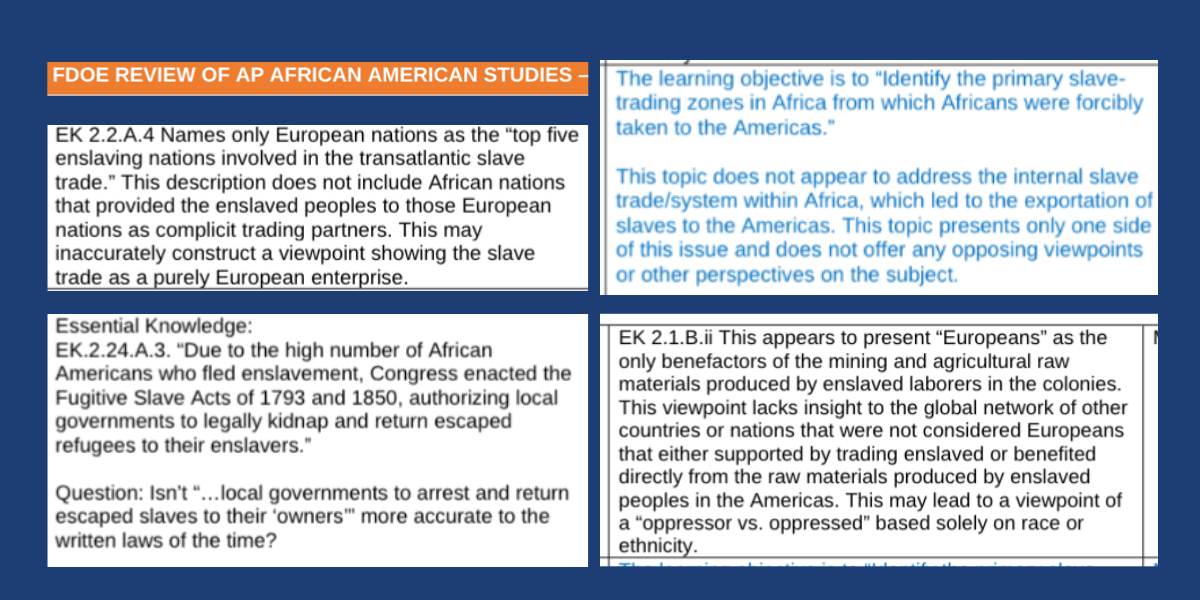
6. Which of these censorship examples are not real?
Florida isn’t the only state that has passed “divisive concept” laws that have confused educators and created an educational chilling effect.
Can you identify which of the following is NOT a real example of censorship prompted by censorship laws?
A. Educators in North Carolina removed a book from a second-grade lesson plan for referring to a character as “they.”
B. Arkansas officials claimed a story might violate the state’s divisive concepts executive order because it included a character who was a Vietnamese monk.
C. A North Carolina elementary school teacher’s assistant requested guidance on whether they could teach about artist Frida Kahlo since she was “in some way connected with LGBTQ community.”
D. An Oklahoma teacher asked their school principal if it was acceptable to include a lesson about President Barack Obama during Black History month.

Answer: D
Click here to learn more.
We did not uncover an instance of a teacher who was afraid to teach about Barack Obama. However, we did uncover other examples of teachers who were afraid to teach about Black history.
For example, in 2023, the Florida Department of Education rejected the textbook “The African American Experience” — which contained information about George Floyd’s murder and the 2017 “Unite the Right” white supremacist rally in Charlottesville — without providing an explanation for the rejection.
Public records obtained by American Oversight reveal that in 2024, in response to the anti-indoctrination law HB 7, Orange County Public Schools administrators eliminated a sentence from a Black History Month proclamation that said, “[M]ore than 150 years after slavery was abolished in this nation, our society is still grappling with racial inequality and injustice as we strive toward a more perfect union.”
School administrators had included an almost identical sentence in proclamations issued the previous three years.
Additionally, in a February 2024 email chain among Orange County school officials about HB 7, one administrator wrote that it was important that a facilitator offering a group student mentorship program, “understands that nothing [taught] can talk about social justice, implicit bias, or the existence of racism.”
The other examples are all real. Here are the records that show these teacher’s inquiries.
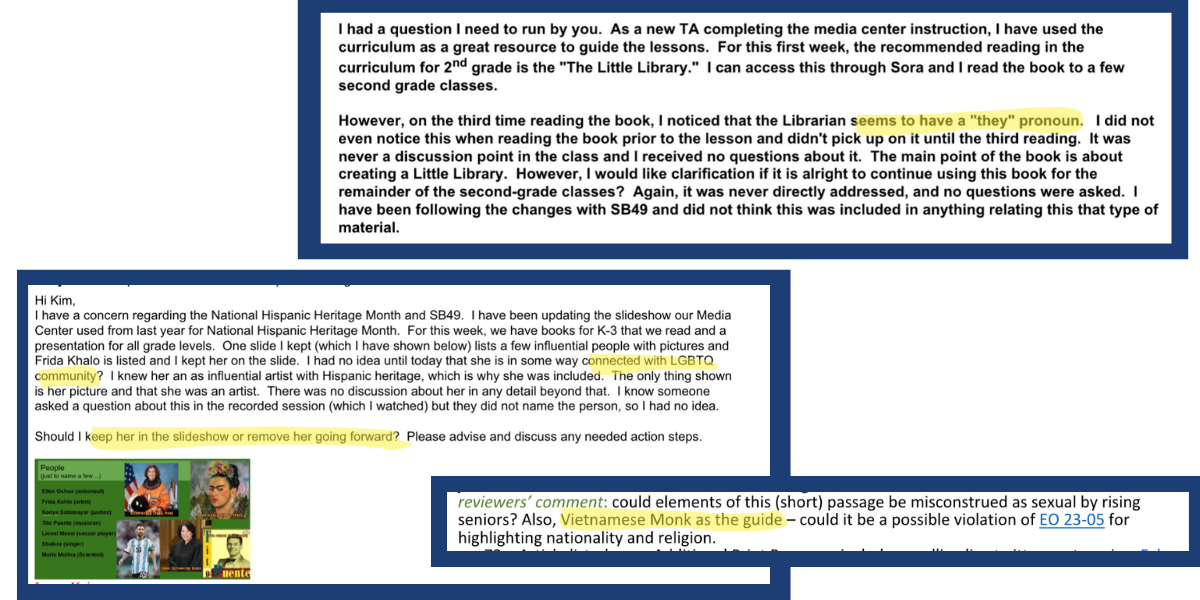
6. What revisions were made to Virginia’s African American history course?
In 2023, the Virginia Department of Education reviewed the state’s African American history elective course, which had been developed by the previous administration and a committee of experts. The department prepared a list of “suggested revisions” to help the course comply with the order.
Which of the following is not a real example of a suggested change to the course?
A. Delete the number of people enslaved in the United States.
B. Remove the claim that eugenics is pseudoscience.
C. Remove the statement that the “Lost Cause” myth about the Civil War continues to influence U.S. society.
D. Reparaphrase Martin Luther King Jr.’s criticism of “white moderates” as the “great stumbling block in [the] stride toward freedom” to refer only to “moderates.”

Answer: A
Click here to learn more.
As far as we know, the reviewers did not ask that this figure be removed from the textbook. However, we do know that the other examples are real suggested revisions.

7. What was flagged for “potential LGBTQ+ interpretation?”
Which of the following was flagged for “potential LGBTQ+ interpretation” by a school district in North Carolina?
A. An episode of the Dora the Explorer children’s show about friendship.
B. An episode of the Bluey children’s show about different types of families.
C. A Sesame Street video about bullying.
D. A Youtube video about the color red.

Answer: C
Click here to learn more.
Yes, a Sesame Street video about bullying was flagged for “potential LGBTQ+ interpretation.”
While a Youtube video about the color red was not flagged, a children’s book entitled “Red: A Crayon’s Story” was. Other materials flagged included “Odd Velvet” and a Title IX presentation for high school students, which was flagged because a slide on flirting and harassment included an image of two women holding hands. Additionally, a slide on “Bystander Intervention” in another Title IX presentation was also flagged, presumably because it included an image of one woman hugging another.
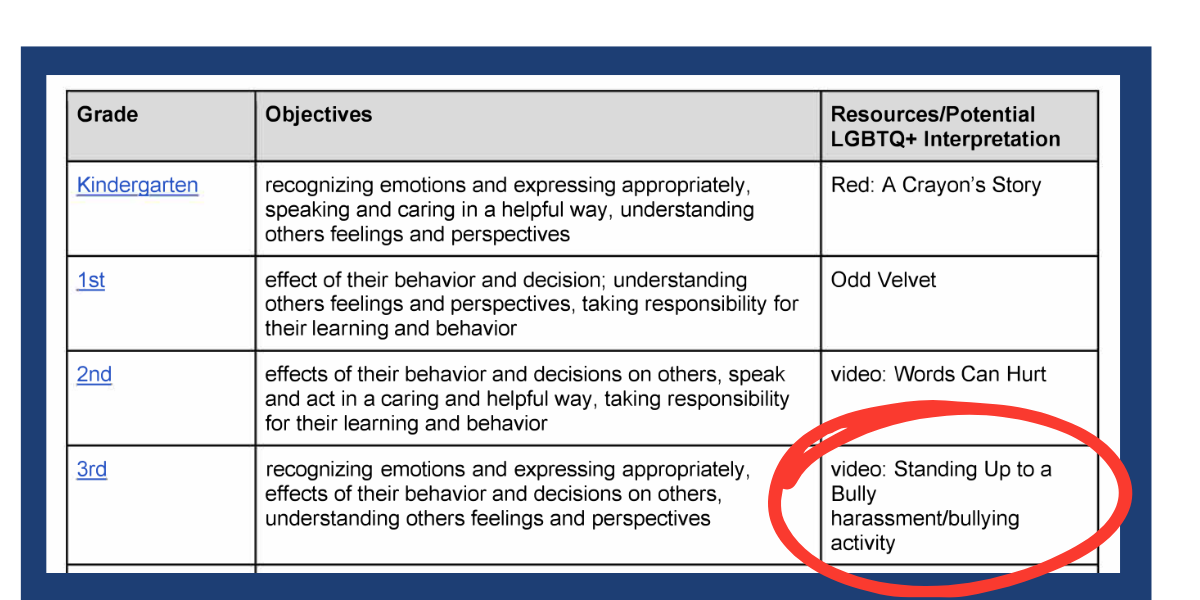
8. Can you identify the real examples of censorship in Georgia?
In 2022, Georgia passed HB 1084, a law banning classroom discussions related to certain so-called “divisive concepts.” Records obtained by American Oversight provide new details about how laws restricting classroom instruction on racism and related topics led to the removal of books from school libraries in Georgia — yet another example of how such measures limit students’ ability to learn about inequality and diverse experiences.
The documents, reported on by Rebecca Gaunt for the Cobb County Courier, show that in August 2023, at least 30 recently acquired books with LGBTQ characters and themes were removed from high school libraries in Cobb County. The records also show that certain classic works of literature, including some by William Shakespeare, were also flagged for review.
Which of the following is not a real example of a book flagged for review and the corresponding reasoning?
A. “Dracula” was flagged because of “vampires drinking blood.”
B. “Frankenstein,” for age-inappropriate violence.
C. “The Cage,” for “Holocaust content … nothing too specific.”
D. “Romeo and Juliet” and “Antony and Cleopatra,” for references to suicide.

Answer: B
Click here to learn more.
As far as we know, Frankenstein was not flagged by the board but all of the other examples are real.
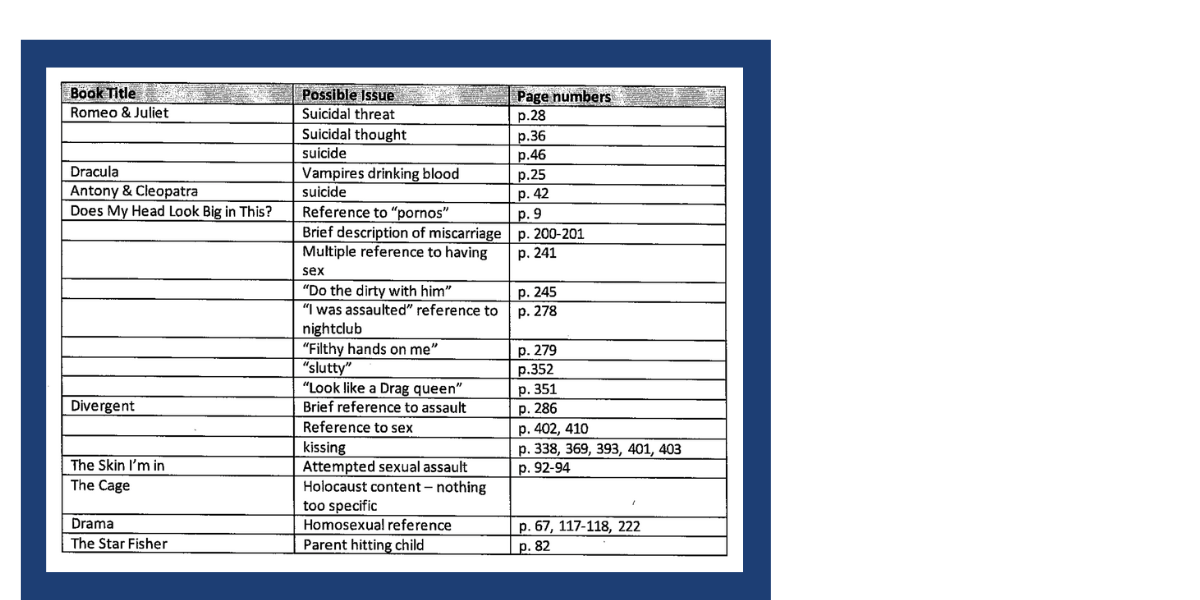
The documents used to create this quiz — obtained from dozens of public records requests filed by American Oversight — demonstrate how the flood of educational restrictions has created confusion and fear among educators. These “divisive concepts” laws have proven so effective at chilling instruction that many teachers have preemptively removed potentially controversial material, avoiding lessons about people who are not heterosexual, white, Christian, or American.
As children head back to school this year, many will be denied the full education they have the right to thanks to these laws, potentially denying them the ability to navigate and meaningfully participate in a multicultural world with diverse viewpoints.
You can read more about the chilling effect of these laws — as well as how they threaten the foundational principles of public education and democracy — in our recent report, “The Far-Right Attack on Education: How Curriculum and Classroom Censorship Stifles Educators, Harms Students, and Threatens Our Democracy.” Read more about Florida pioneered many of the divisive concept laws that the Trump administration hopes to enforce on the federal level in this recent report from the Florida Freedom to Read Project and PEN America, “The Blueprint State: Lessons from Parents Left Behind by “Parental Rights” Policies in Florida.”